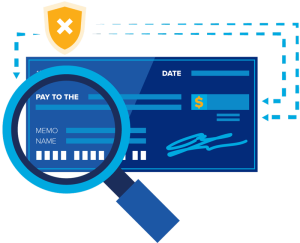Check fraud continues to be a significant problem facing the payments industry. Financial institutions and industry surveys report (Off-site) that paper checks and electronic images of paper checks are among the most prevalent sources of fraud attempts, causing billions of dollars in losses annually within the United States alone.
The Federal Reserve supports the payments industry in the fight against check fraud. This check fraud mitigation toolkit offers a wide range of informative resources.
Why is it Important to Combat Check Fraud?
 Check fraud has increased significantly over the years despite declining check volumes. Focused efforts can help mitigate the substantial impacts of check fraud on financial institutions, businesses and consumers within the United States. These impacts include:
Check fraud has increased significantly over the years despite declining check volumes. Focused efforts can help mitigate the substantial impacts of check fraud on financial institutions, businesses and consumers within the United States. These impacts include:
Financial losses. Financial institutions, businesses and consumers all are financially impacted by check fraud. For example, check fraud (Off-site) generally accounts for about a third of financial institutions’ fraud losses. However, reported numbers and estimates may not include financial losses due to the overhead and operational costs of resolving check fraud events within financial institutions and businesses. Consumers and businesses also report losses due to fake or stolen checks.
Loss of trust. Fraud events cause more than risk and financial losses — they also can erode trust due to a negative customer experience. In addition, victims may believe that fraudulent checks should have been prevented, cases resolved more quickly, or that safer practices by the payments issuer could have resulted more timely, accurate payments.
Operational disruptions. Compromised accounts and missing payments due to check fraud can disrupt businesses’ normal course of operations. Remediating check fraud often is time-consuming and manually intensive, especially if this requires opening and transferring funds to a new account. In turn, it is important to monitor outstanding checks that were issued and re-establish existing payments and services.
Why Does Check Fraud Continue to be an Issue?
Check fraud is on the rise, even as the number of checks in circulation has declined. Why? In this podcast (Off-site), Federal Reserve Bank of Boston payments fraud expert Mike Timoney discusses why checks are an attractive target for thieves and how consumers can protect themselves.
The check fraud mitigation toolkit was developed by the Federal Reserve to help educate the industry about check fraud and outline potential ways to help detect and mitigate this fraud type. Insights for this toolkit were provided through interviews with industry experts, publicly available research, and team member expertise. This toolkit is not intended to result in any regulatory or reporting requirements, imply any liabilities for fraud loss, or confer any legal status, legal definitions, or legal rights or responsibilities. While use of this toolkit throughout the industry is encouraged, utilization of the toolkit is voluntary at the discretion of each individual entity. Absent written consent, this toolkit may not be used in a manner that suggests the Federal Reserve endorses a third-party product or service.

